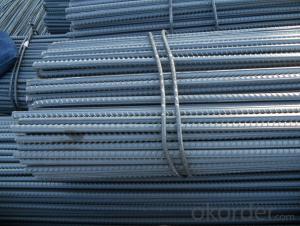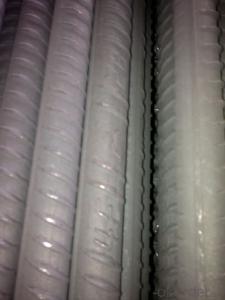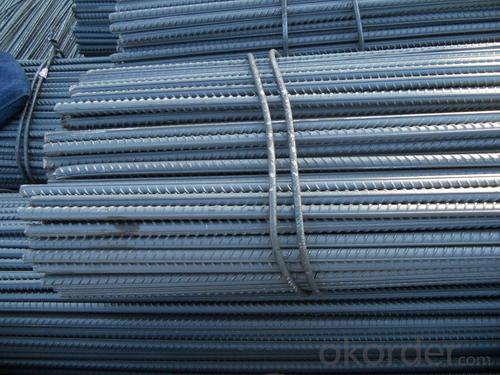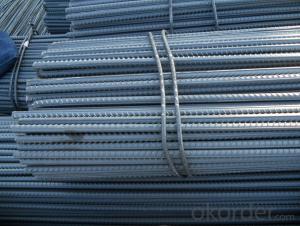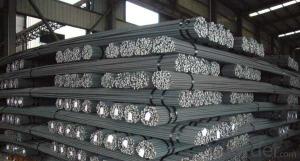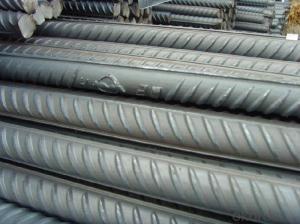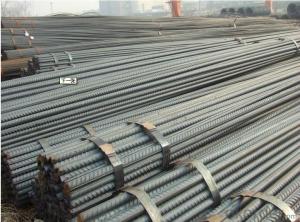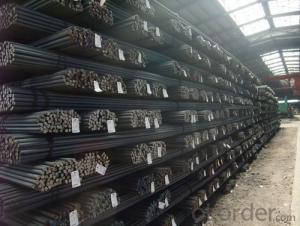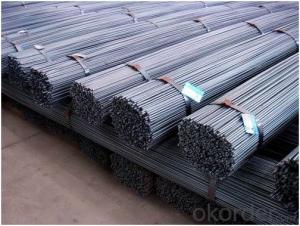Hot Rolled Deformed Steel Rebars for Buildings ASTM Standard
- Loading Port:
- Guangzhou
- Payment Terms:
- TT OR LC
- Min Order Qty:
- 25 m.t.
- Supply Capability:
- 200000 m.t./month
OKorder Service Pledge
OKorder Financial Service
You Might Also Like
Product Description:
OKorder is offering Hot Rolled Deformed Steel Rebars for Buildings ASTM Standard at great prices with worldwide shipping. Our supplier is a world-class manufacturer of steel, with our products utilized the world over. OKorder annually supplies products to European, North American and Asian markets. We provide quotations within 24 hours of receiving an inquiry and guarantee competitive prices.
Product Applications:
Hot Rolled Deformed Steel Rebars for Buildings ASTM Standard are ideal for structural applications and are widely used in the construction of buildings and bridges, and the manufacturing, petrochemical, and transportation industries.
1. Supporting members, most commonly in the house raising industry to strengthen timber bears under houses. Transmission line towers, etc
2. Prefabricated structure
3. Medium scale bridges
4. It is widely used in various building structures and engineering structures such as roof beams, bridges, transmission towers, hoisting machinery and transport machinery, ships, industrial furnaces, reaction tower, container frame and warehouse etc.
Product Advantages:
Hot Rolled Deformed Steel Rebars for Buildings ASTM Standard are durable, strong, and resist corrosion. And they are made of steel billets of high quality of China.
Main Product Features:
· Premium quality
· Prompt delivery & seaworthy packing (30 days after receiving deposit)
· Corrosion resistance
· Can be recycled and reused
· Mill test certification
· Professional Service
· Competitive pricing
Product Specifications:
Our supplier is a world-class manufacturer of steel, with our products utilized the world over. OKorder annually supplies products to European, North American and Asian markets. We provide quotations within 24 hours of receiving an inquiry and guarantee competitive prices.
Product Specifications:
Specifications of Hot Rolled Deformed Steel Rebars for Buildings ASTM Standard:
Standard | GB UK USA | HRB335 HRB400 HRB500 G460B, B500A, B500B,B500C GR40, GR60 | |
Diameter | 6mm,8mm,10mm,12mm,14mm,16mm,18mm,20mm, 22mm,25mm,28mm,32mm,36mm,40mm,50mm | ||
Length | 6M, 9M,12M or as required | ||
Packing | Export standard packing: wrapped by wire rod in bundles | ||
Each bundle weight | 2-3MT, or as required | ||
Trade terms | FOB, CFR, CIF | ||
Payment terms | TT payment in advance or Irrevocable LC at sight. | ||
Delivery Detail | within 45 days after received advanced payment or LC. | ||
Brand name | DRAGON | ||
Theoretical weight and section area of each diameter as below for your information:
Diameter(mm) | Section area (mm²) | Mass(kg/m) | Weight of 12m (kg) | Pcs/ton |
6 | 28.27 | 0.222 | 2.664 | 375.38 |
8 | 50.27 | 0.395 | 4.74 | 210.97 |
10 | 78.54 | 0.617 | 7.404 | 135.06 |
12 | 113.1 | 0.888 | 10.656 | 93.84 |
14 | 153.9 | 1.21 | 14.52 | 68.87 |
16 | 201.1 | 1.58 | 18.96 | 52.74 |
18 | 254.5 | 2.00 | 24 | 41.67 |
20 | 314.2 | 2.47 | 29.64 | 33.74 |
22 | 380.1 | 2.98 | 35.76 | 27.96 |
25 | 490.9 | 3.85 | 46.2 | 21.65 |
28 | 615.8 | 4.83 | 57.96 | 17.25 |
32 | 804.2 | 6.31 | 75.72 | 13.21 |
36 | 1018 | 7.99 | 98.88 | 10.43 |
40 | 1257 | 9.87 | 118.44 | 8.44 |
50 | 1964 | 15.42 | 185.04 | 5.40 |
Chemical Composition: (Please kindly find our chemistry of our material based on JIS as below for your information)
JISG3112 SD390 | Chemical Composition | ||||
C | Mn | Si | S | P | |
0.22 | 1.38 | 0.4 | 0.014 | 0.022 | |
Physical capability | |||||
Yield Strength(N/cm²) | Tensile Strength(N/cm²) | Elongation (%) | |||
620 | ≥400 | 21 | |||
The production process of Steel Rebar

1-Waling beam furnace 2-Roughing rolling group 3-Intermediate rolling train
4-Finishing rolling group 5-Water-cooling device 6-Walking beam cooler
7-Finishing equipment(including the cold scale shear,short feet collection system,
automatic counting device,bundling machine, collect bench)
Usage and Applications of Hot Rolled Deformed Steel Rebars for Buildings ASTM Standard:
Hot Rolled Deformed Steel Rebars for Buildings GB Standard is widely used in buildings, bridges, roads and other engineering construction. Big to highways, railways, bridges, culverts, tunnels, public facilities such as flood control, dam, small to housing construction, beam, column, wall and the foundation of the plate, deformed bar is an integral structure material. With the development of world economy and the vigorous development of infrastructure construction, real estate, the demand for deformed bar will be larger and larger..
Packaging & Delivery of Hot Rolled Deformed Steel Rebars for Buildings ASTM Standard:
Packaging Detail: products are packed in bundle and then shipped by container or bulk vessel, deformed bar is usually naked strapping delivery, when storing, please pay attention to moisture proof. The performance of rust will produce adverse effect.
Price: Keep lower operating costs so as to offer competitive price for our clients
Deformed Steel Rebars according to Korean standard
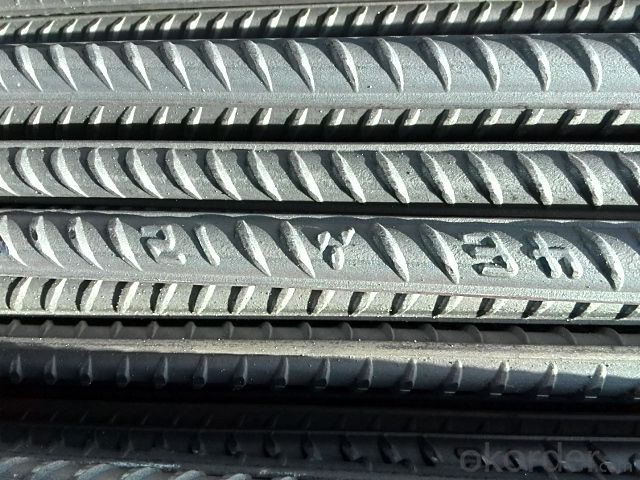
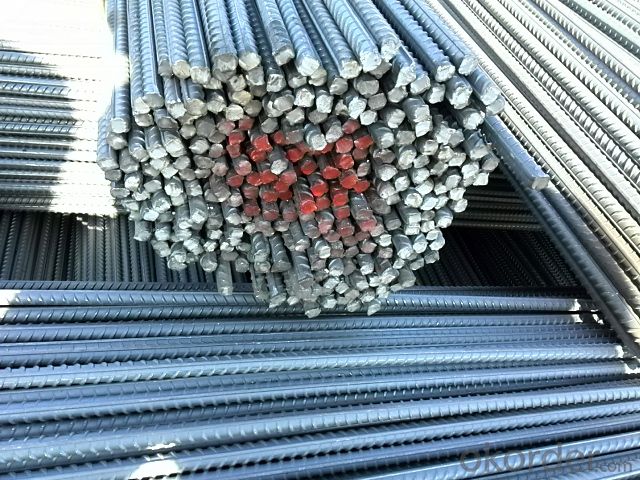
FAQ:
Q1: How do we guarantee the quality of our products?
A2: We have established an advanced quality management system which conducts strict quality tests at every step, from raw materials to the final product. At the same time, we provide extensive follow-up service assurances as required.
Q2: Why buy Deformed Steel Rebars for Buildings ASTM Standard from OKorder.com?
A1: All products offered byOKorder.com are carefully selected from China's most reliable manufacturing enterprises. Through its ISO certifications, OKorder.com adheres to the highest standards and a commitment to supply chain safety and customer satisfaction.
Q3: How soon can we receive the product after purchase?
A3: Within three days of placing an order, we will begin production. The specific shipping date is dependent upon international and government factors, but is typically 7 to 10 workdays.
- Q: What is the effect of steel rebars on the formwork design?
- Steel rebars have a significant effect on the formwork design in construction projects. These rebars, also known as reinforcement bars, are used to provide strength and stability to concrete structures. One of the main effects of steel rebars on formwork design is the need for proper positioning and spacing of the rebars within the formwork. The formwork needs to be designed to accommodate the rebars and allow for their proper placement in order to ensure the structural integrity of the concrete element. This may involve creating openings or recesses in the formwork to allow the rebars to pass through. The presence of steel rebars also affects the size and dimensions of the formwork. Since the rebars occupy space within the concrete element, the formwork needs to be adjusted accordingly to accommodate these additional materials. This may require increasing the size or thickness of the formwork to accommodate the desired concrete cover over the rebars. Another effect of steel rebars on formwork design is the consideration of the weight and load-bearing capacity of the formwork system. Steel rebars can add significant weight to the concrete structure, and the formwork needs to be designed to withstand this additional load. This may involve using stronger and more robust materials for the formwork, as well as ensuring proper bracing and support. Furthermore, the presence of steel rebars may also impact the formwork construction process. The formwork needs to be carefully designed to allow for the installation and removal of the rebars without compromising the integrity of the formwork system. This may involve incorporating removable sections or panels in the formwork design to facilitate the placement and removal of the rebars. In conclusion, steel rebars have a significant effect on the formwork design in construction projects. They require careful consideration and planning to ensure proper positioning, spacing, and support within the formwork. The presence of rebars also affects the size, dimensions, weight, and construction process of the formwork system. Overall, proper integration of steel rebars within the formwork design is crucial for the successful construction of durable and structurally sound concrete elements.
- Q: How do steel rebars affect the overall construction timeline?
- Steel rebars can significantly impact the overall construction timeline. Their presence ensures the structural integrity and strength of concrete structures, such as buildings and bridges. However, the installation, positioning, and securing of rebars can be time-consuming and require meticulous planning and coordination. Any delays or errors in rebar installation can potentially slow down the construction process, impacting the timeline. Therefore, it is crucial to efficiently manage the procurement, fabrication, and installation of rebars to keep the construction timeline on track.
- Q: What is the maximum length of steel rebars available in the market?
- The maximum length of steel rebars available in the market can vary, but commonly they are available in lengths up to 60 feet or 18 meters.
- Q: What is the effect of moisture on steel rebars?
- The effect of moisture on steel rebars can be significant and can lead to various issues. Moisture can accelerate the corrosion process of steel rebars, causing them to rust and deteriorate over time. This corrosion weakens the structural integrity of the rebars and can lead to structural failures in concrete structures. When steel rebars are exposed to moisture, the water reacts with the iron in the steel, causing an electrochemical reaction known as corrosion. This reaction produces iron oxide or rust, which expands and causes the rebars to crack and spall. As the corrosion progresses, the rebars lose their strength, which can compromise the overall stability of the structure. Moisture can also contribute to the formation of carbonation in concrete, which further increases the risk of corrosion for steel rebars. Carbonation occurs when carbon dioxide from the atmosphere reacts with the calcium hydroxide in concrete, reducing the alkalinity of the concrete. This reduction in alkalinity lowers the passivation of the rebars, making them more susceptible to corrosion. In addition to corrosion, moisture can also lead to other problems such as concrete expansion, freeze-thaw damage, and efflorescence. When moisture enters the concrete and freezes, it expands, causing cracking and spalling. This freeze-thaw cycle can further accelerate the corrosion process of steel rebars. Efflorescence, on the other hand, is the crystalline deposit that forms on the surface of concrete when moisture evaporates and leaves behind salts. This white, powdery substance can degrade the appearance of concrete structures and indicate potential moisture-related issues. To mitigate the effects of moisture on steel rebars, various preventive measures can be taken. These include using corrosion-resistant rebars, applying protective coatings or membranes to the rebars, ensuring proper concrete cover over the rebars, and implementing proper drainage systems to prevent the accumulation of moisture. Regular inspections and maintenance are also crucial to identify and address any moisture-related issues before they escalate and cause structural problems.
- Q: What are the different types of supports used for steel rebars in formwork?
- There are several types of supports used for steel rebars in formwork, including chairs, spacers, and continuous supports. Chairs are small plastic or metal devices that are placed under the rebars to elevate them above the formwork surface. Spacers are similar to chairs but are used to maintain the correct spacing between rebars. Continuous supports, such as beams or blocks, are used to provide continuous support along the length of the rebars to prevent sagging or bending.
- Q: Can steel rebars be used in structures with long spans?
- Yes, steel rebars can be used in structures with long spans. Steel rebars are commonly used as reinforcement in concrete structures to provide added strength and stability. They can effectively distribute tensile forces and help prevent cracks or failure in the concrete. In structures with long spans, such as bridges, high-rise buildings, or large industrial structures, steel rebars are often used to reinforce the concrete beams, slabs, and columns. This helps to ensure the structural integrity and stability of the building or structure, even under heavy loads or over long distances. Steel rebars have high tensile strength and are resistant to corrosion, making them suitable for use in long-span structures where durability and reliability are important factors.
- Q: How do steel rebars contribute to the sustainability of a building?
- Steel rebars contribute to the sustainability of a building in several ways. Firstly, they provide structural strength and durability, allowing the building to withstand natural disasters and remain functional for a longer period. This reduces the need for frequent repairs or reconstruction, ultimately reducing resource consumption and waste generation. Secondly, steel rebars are recyclable, meaning they can be reused in future construction projects, reducing the demand for raw materials and minimizing the environmental impact of steel production. Additionally, the use of steel rebars in reinforced concrete structures allows for the use of thinner and lighter concrete sections, resulting in reduced material usage and lower carbon emissions during construction and transportation. Overall, steel rebars enhance the longevity, efficiency, and environmental performance of buildings, making them more sustainable.
- Q: What are the different types of steel rebars used in underground structures?
- There exists a variety of steel rebars that are frequently utilized in underground structures, each possessing its own unique properties and characteristics. The decision regarding which type of rebar to use depends on a multitude of factors, such as the project's specific requirements, the necessary load-bearing capacity, and the environmental conditions of the underground structure. To begin with, there are mild steel rebars, which are also referred to as carbon steel rebars. These are the most commonly employed type due to their affordability and widespread availability. Mild steel rebars possess a low carbon content and offer commendable tensile strength, rendering them suitable for general construction purposes in underground structures. Next, we have high strength deformed (HSD) rebars, which are crafted from carbon steel and undergo additional heat treatment processes. These processes result in heightened yield strength and improved resistance to corrosion. HSD rebars find common usage in areas with high seismic activity or in situations where an increased load-bearing capacity is required. Furthermore, there are epoxy-coated rebars, which are specifically designed to combat aggressive environments that underground structures can be exposed to, including moisture and chemicals. By applying an epoxy coating to the surface of the rebar, enhanced corrosion resistance is achieved. This coating acts as a protective barrier, reducing the risk of corrosion and prolonging the lifespan of the rebar. Stainless steel rebars also play a significant role in underground structures. They possess an exceptional resistance to corrosion, which makes them ideal for usage in harsh underground environments. They prove particularly beneficial in structures where chloride or other corrosive agents are present, such as underground water treatment facilities or sewer systems. Lastly, there are galvanized rebars, which are coated with a layer of zinc to provide corrosion protection. This type of rebar is commonly employed in underground structures where moisture or exposure to corrosive elements is a concern. The zinc coating acts as a sacrificial layer, corroding in place of the rebar and extending its service life. In conclusion, underground structures employ various types of steel rebars, including mild steel rebars, high strength deformed rebars, epoxy-coated rebars, stainless steel rebars, and galvanized rebars. The selection of the appropriate rebar type is contingent upon the specific requirements and environmental conditions of the underground structure.
- Q: What are the guidelines for handling and installing steel rebars in construction sites?
- The guidelines for handling and installing steel rebars in construction sites typically include the following: 1. Storage: Steel rebars should be stored on a flat and dry surface, preferably on elevated racks to prevent contact with the ground and avoid rusting or damage. 2. Transportation: Rebars should be moved using appropriate lifting equipment, such as cranes or forklifts, to prevent excessive bending or mishandling. 3. Inspection: Rebars should be inspected for any defects, such as bends, cracks, or excessive rust, before installation. Damaged rebars should not be used. 4. Cutting and bending: Rebars should be cut and bent using appropriate tools and equipment, following the specifications and dimensions provided in the construction plans. 5. Placement: Rebars should be placed accurately and securely within the concrete structures, ensuring proper alignment and spacing as per the design requirements. 6. Tying: Rebars should be securely tied together using wire or approved tying methods at the intersections to maintain the desired positions during concrete pouring. 7. Embedment: Rebars should be properly embedded within the concrete to ensure sufficient coverage, typically complying with the minimum concrete cover specified in the design. 8. Safety: Adequate personal protective equipment (PPE), such as gloves and safety boots, should be worn by workers during rebars handling and installation to prevent injuries. It is important to note that specific construction projects and local regulations may have additional guidelines or requirements for handling and installing steel rebars. Therefore, it is crucial to refer to the project specifications and consult with relevant experts or authorities for comprehensive guidelines.
- Q: How do steel rebars affect the overall maintenance requirements of concrete structures?
- The overall maintenance requirements of concrete structures are greatly influenced by steel rebars. These reinforcing bars serve a critical role in improving the strength and longevity of concrete by providing tensile strength and preventing cracks. When steel rebars are added to concrete, the structure becomes better equipped to withstand external forces it may encounter throughout its lifespan. One primary way in which steel rebars impact maintenance requirements is by decreasing the likelihood of cracks in concrete structures. While concrete is strong in compression, it is weak in tension. When exposed to tensile forces such as loads or temperature changes, concrete tends to crack. However, incorporating steel rebars within the concrete helps minimize or even prevent these cracks. This is because the steel rebars absorb the tensile forces, allowing the concrete to remain intact. As a result, structures that remain intact require less maintenance. Additionally, steel rebars also enhance the overall strength of concrete structures, making them more resistant to external forces. This increased strength reduces the risk of structural failure, thereby reducing maintenance requirements in terms of repairs or replacements. Furthermore, the use of steel rebars can extend the lifespan of concrete structures as they provide the necessary reinforcement to withstand the test of time. However, it is important to note that steel rebars can be susceptible to corrosion over time, which can impact the maintenance requirements of concrete structures. When steel rebars corrode, they expand, leading to cracks and spalling in the concrete. Various factors such as moisture exposure, chloride ions, or carbonation can accelerate this corrosion. Therefore, regular inspections and maintenance measures, such as protective coatings or cathodic protection, must be implemented to prevent or manage the corrosion of steel rebars. In conclusion, steel rebars have a significant impact on the overall maintenance requirements of concrete structures. They improve the strength, durability, and resistance of concrete, reducing the occurrence of cracks and structural failures. However, proper maintenance and protection against corrosion are essential to ensure the continued effectiveness of steel rebars, ultimately contributing to the longevity and low maintenance needs of concrete structures.
Send your message to us
Hot Rolled Deformed Steel Rebars for Buildings ASTM Standard
- Loading Port:
- Guangzhou
- Payment Terms:
- TT OR LC
- Min Order Qty:
- 25 m.t.
- Supply Capability:
- 200000 m.t./month
OKorder Service Pledge
OKorder Financial Service
Similar products
Hot products
Hot Searches
Related keywords
